Abstract:
The core performance elements of global navigation satellite system include availability, continuity, integrity and accuracy, all of which are particularly important for the developing BeiDou global navigation satellite system (BDS-3). This paper describes the basic performance of BDS-3 and suggests some methods to improve the positioning, navigation and timing (PNT) service. The precision of the BDS-3 post-processing orbit can reach centimeter level, the average satellite clock ofset uncertainty of 18 medium circular orbit satellites is 1.55 ns and the average signal-inspace ranging error is approximately 0.474 m. The future possible improvements for the BeiDou navigation system are also discussed. It is suggested to increase the orbital inclination of the inclined geostationary orbit (IGSO) satellites to improve the PNT service in the Arctic region. The IGSO satellite can perform part of the geostationary orbit (GEO) satellite’s functions to solve the southern occlusion problem of the GEO satellite service in the northern hemisphere (namely the “south wall efect”). The space-borne inertial navigation system could be used to realize continuous orbit determination during satellite maneuver. In addition, high-accuracy space-borne hydrogen clock or cesium clock can be used to maintain the time system in the autonomous navigation mode, and stability of spatial datum. Furthermore, the ionospheric delay correction model of BDS-3 for all signals should be unifed to avoid user confusion and improve positioning accuracy. Finally, to overcome the vulnerability of satellite navigation system, the comprehensive and resilient PNT infrastructures are proposed for the future seamless PNT services.
Keywords : BDS-3, PNT, Performance, Constellation, Ionospheric delay
Introduction
The BeiDou navigation satellite system(BDS)provides more services compared with other global navigation sat-ellite systems(GNSSs).Te BeiDou global navigation sat-ellite system,(BDS-3),is the third step of China’s satellite navigation system construction.In addition to the positioning,navigation and timing(PNT)service pro-vided by all GNSSs,BDS-3 also provides regional mes-sage communication(1000 Chinese characters per time)and global short message communication(40 Chinese characters per time),global search and rescue service(SAR),regional precise point positioning(PPP)service,embedded satellite-based augmentation service(BDS-BAS),and space environment monitoring function.By the end of 2019,28 BDS-3 satellites had been suc-cessfully launched,including 24 medium circular orbit(MEO)satellites,3 inclined geostationary orbit(IGSO)satellites and 1 geostationary orbit(GEO)satellite.How-ever,only 18 MEO satellites can provide services thus far,and other satellites are in test phase.

添加微信好友, 獲取更多信息
復制微信號
Te BDS-3 baseline system with 18 MEO satellites has begun providing initial services to global users on December 27,2018,and at least fve satellites are vis-ible for global users.Many scholars have described the BDS-3 status and the main service function indexes,including the constellation design,service type,navigation signal system,space?Ctime datum and orbit determination method of BDS-3 system,etc.Te space?Ctime datum,signal-in-space quality,accuracy of satellite broadcast ephemeris,the accuracy of the post-process-ing precise orbit,time synchronization accuracy,sat-ellite clock ofset accuracy and the basic PNT service performance of the BDS-3 baseline system have be cal-culated and *** yzed.Because BDS-3 satel-lites are equipped with inter-satellite links(ISL),more research achievements have been made in the felds of ISL supported determination of satellite orbit and clock ofset.According to the preliminary calcu-lation results,the ranging accuracy of the ISLs of BDS-3 is about 4 cm;if the satellite orbits are determined using only regional station observations,the three-dimensional orbit accuracy of the overlapping arc is about 60 cm;with ISL measurements,the orbit accuracy is about 30 cm,the 24-h orbit prediction accuracy is also raised from 140 to 51 cm,and the radial accuracy can reach 10 cm,as eva luated through laser observations.
Te performance of BDS-3 presented by diferent scholars,using diferent data sources,are highly similar to each other.From the aspect of signal,the ratio bias of signal component efective power is better than 0.25 dB,the S curve bias is less than 0.3,the signal-in-space accu-racy calculated with post-processing ephemeris and broadcast ephemeris is approximately 0.5 m(root mean square,RMS),and the signal-in-space continuity and availability are approximately 99.99%and 99.78%,respec-tively.Te timing accuracy is better than 19.1 ns(95%),which satisfes the system service performance specifcations.Compared with BDS-2,BDS-3 exhib-its signifcant improvement in system coverage,spatial signal accuracy,availability and continuity.At the user’s end,service improvements such as the BDS-3 sig-nal design and optimal receiving mode,precision orbit determination,and precise point posi-tioning technologyhave been reported in relevant literature and will not be repeated herein.
Te main performance eva luation methods and formu-lae are given in the second section.Te current perfor-mance of BDS-3 by the end of August 2019 is presented and *** yzed in the third section.Under normal circum-stances,the main performance indicators provided by BDS-3 can satisfy or surpass the design indicators,which are comparable to the service performance of other GNSSs.Te possible improvement strategies for BDS-3 are presented in the fourth section from the aspects of system construction,satellite constellation,satellite pay-load,etc.Conclusions are presented in the fnal section of the paper.
Performance eva luation methods
Te spatial signal accuracies of BDS-3 include broadcast orbit accuracy,broadcast clock ofset accuracy,signal-in-space ranging error(SISRE),broadcast ionospheric delay model accuracy,etc.Specifc eva luation methods are as follows:
Broadcast orbit accuracy:the post precise satellite posi-tions are taken as references,and the accuracy of the positions calculated by the broadcast ephemeris is the eva l-uation object.Te root mean square error(RMSE)of the broadcast orbit is eva luated using the diferences(errors of the broadcast orbit)of the broadcast and precise satellite orbits in the same coordinate system,i.e.China Geodetic Coordinate System 2000(CGCS2000)and the same time scale,i.e.BDS time(BDT).Te orbit error can be obtained using the following formula

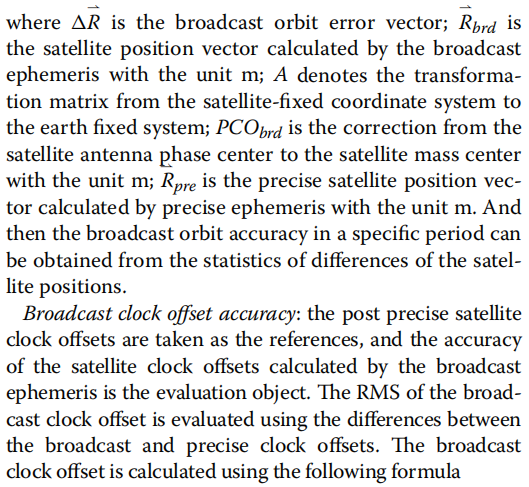

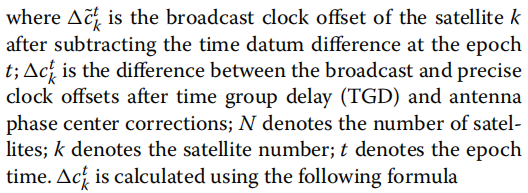

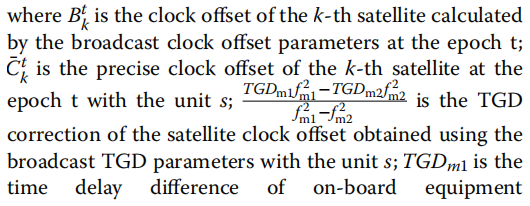
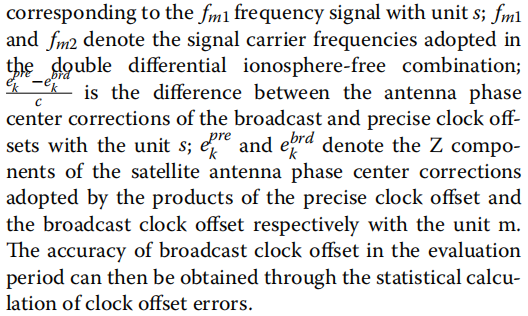
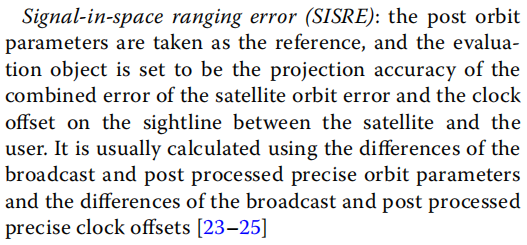

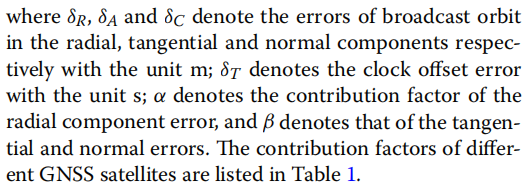

Table 1 Average contribution factors of satellites on SISREelevation mask angle:59)
Broadcast ionospheric model accuracy:the post-pro-cessing high-precision grid ionospheric delay model is taken as the reference model,and the accuracy of the broadcast ionospheric zenith delay value is the eva lu-ation object.In this paper,the accuracy of BeiDou global broadcast ionospheric delay correction model(BDSGIM)is eva luated[26].Four indexes are used for eva luation,including average bias,standard deviation,RMSE and correction percentage.Te formulae are as follows:
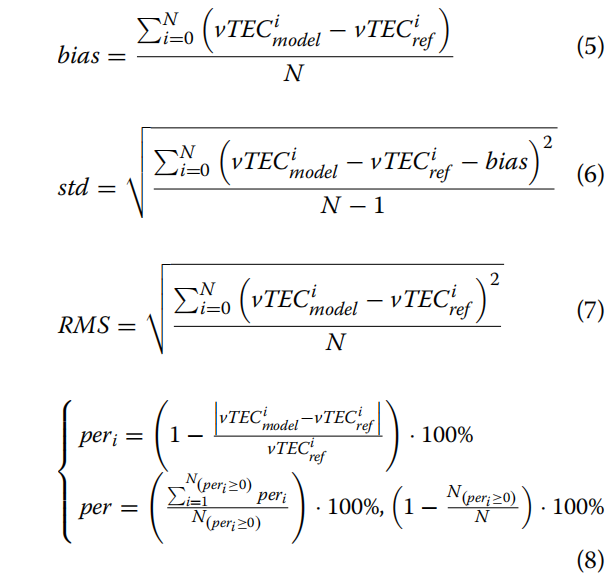

Latest performance of BDS-3
Broadcast satellite orbit accuracy
With the continuous improvement of the BDS-3 basic constellation,the stability and connectivity of the ISL continue to increase,and the performance of the basic constellation improves gradually.Te basic service per-formance of BDS-3 frst depends on the performance of the satellite orbit and satellite clock.Te performance of the BDS-3 post-processing precision orbit was estimated from the observations of international GNSS monitoring asses *** ent service(iGMAS)stations deployed all over the world until July 2019.It indicated that the accuracies of the radial,tangential and normal components of the satellite orbit were 1.5,5.7 and 4.1 cm respectively(seen in Fig.1a),and the accuracies were 8.0,34 and 37 cm,respectively,when the system started ofering global ser-vice in December 2018.

Fig. 1 a Precise orbit accuracy of the BDS-3 basic constellation. b Broadcast orbit accuracy of the BDS-3 basic constellation
As shown,the post-processing orbit accuracy of the BDS-3 satellites are increased by approximately fve,six and nine times,respectively.Te improvement in the normal accuracy is the most signifcant,as the ISL observation is more abundant and stable.Te accuracy of the three components(radial,tangential and nor-mal)of the broadcast orbit of the BDS-3 by referring to the post accurate orbits are 0.059,0.323 and 0.343 m respectively(seen in Fig.1b).Compared with the launch in December 2018,the broadcast orbit has also been signifcantly improved.Furthermore,with the signif-cant improvement of post-processing orbit accuracy,the estimation reliability of broadcast ephemeris based on the post-processing precise orbit has also been increased Accordingly.
Broadcast satellite clock offset accuracy
The uncertainty of the broadcast satellite clock offset is a main factor affecting the user PNT service.The accuracy of the satellite broadcast clock offset is eva luated using the differences of the broadcast satellite clock offsets and post-processing precise ones.The RMS are displayed in Fig.2.
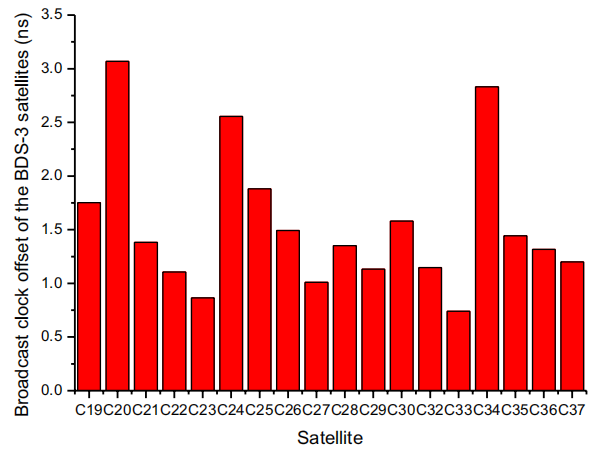
Fig. 2 Broadcast clock offset of the BDS-3 satellites
As shown in the figure,the average uncertainty of sat-ellite clock offset of 18 MEO satellites is 1.55 ns,but the satellite clock offsets of M02,M06 and M15 satellites are3.068,2.555 and 2.832 ns,respectively,which are larger and unstable.
Estimation of SISRE
SISRE of the BDS-3 are estimated based on the post-pro-cessing ephemeris and broadcast ephemeris,which are shown in Fig.3.
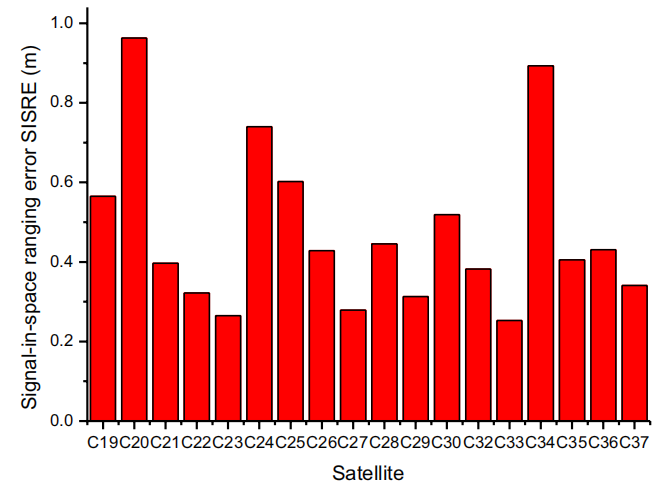
Fig. 3 SISRE of the BDS-3 satellites
Figure 3 shows that the average SISRE is approximately 0.474 m,and all the SISREs are in agreement with the satellite clock ofsets.Te SISRE of the M02,M06 and M15 satellites are signifcantly greater than those of other satellites;when BDS-3 started ofering global service in December 2018,the SISRE was approximately 0.7 m.
Accuracy of ionospheric delay correction models
BDS-3 can broadcast four civil signals,including B1C,B1I,B2a/B2b and B3I.Among them,the B1I and B3I signals are broadcast by both BDS-2 and BDS-3.Tere-fore,the civil signals of BDS-3 adopt two types of iono-spheric models,namely BDSK8 and BDGIM.Te former is used for B1I and B3I which is consistent with those of the BDS-2,while the latter is used for the new signals of BDS-3,i.e.B1a,B1C,B2a and B2b.To *** yze the ionospheric correction accuracy of these two models,we used the global ionospheric maps model constructed by the Center for Orbit Determination in Europe(CODG model)as a reference,and compared the nine-month(from January to September)average accuracies of Nequick,GPSK8,BDGIM and BDSK8 models.Te results are shown in Fig.4,where“high latitude”ranges from 55°to 85°,“mid latitude”from 30°to 55°,and“low latitudes”from 0°to 30°.
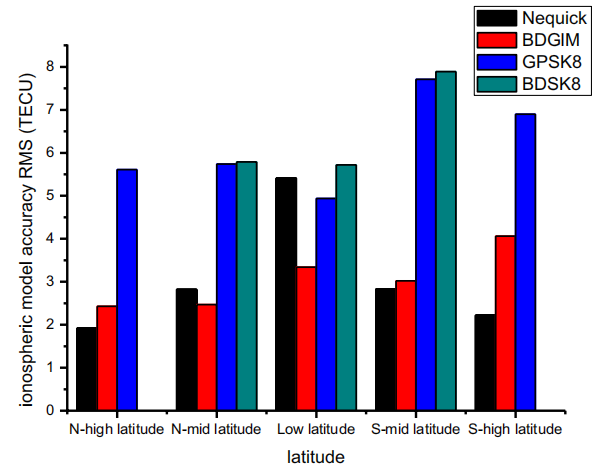
Fig. 4 eva luation of the ionospheric model accuracy in half a year based on CODG model
Figure 4 shows that the correction accuracy of BDGIM model is obviously better than that of all other models in the middle and low latitude zones;in the northern mid-dle and low latitudes,the correction ratio of BDGIM is approximately 75%;in the southern middle latitude zones,the correction ratio is approximately 65%;in the high latitude zones,BDGIM is slightly worse than the Nequick model;the BDGIM performs better than the GPSK8 and BDSK8 model at any latitude.
Te accuracy eva luation details of BDGIM are shown in Table 2,and the correction percentage and data rejec-tion percentage are listed in the last row of low,middle and high latitude columns.
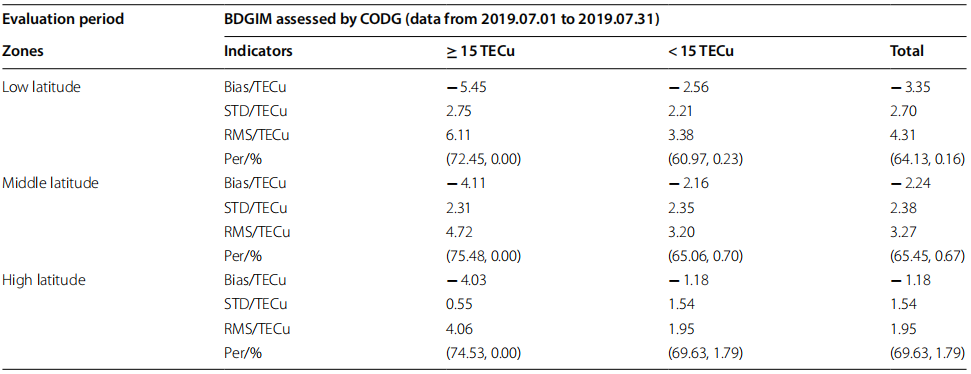
Table 2 Accuracy eva luation of BeiDou global ionospheric model
Table 2 shows that the BDGIM maintains a good cor-rection accuracy,regardless of the ionospheric efect.
According to the performance eva luation of the BDS-3 orbit accuracy,satellite clock ofset accuracy and SISRE,the basic functions and performance of BDS-3 satisfy the design requirements.
Future possible development
Although BDS-3 has developed many new designs and functions,such as satellite orbit design,service function innovation and payload improvements[3-5],there is still room for improvements in the future.
01
Te PNT service performance in high latitude area is poor.Te BDS-3 constellation is composed of 24 MEO,3 GEO and 3 IGSO satellites.Te inclina-tion of MEO and IGSO satellites is 55°,which indi-cates that the service performance of BDS-3 will be signifcantly degraded in high latitude area.First,all visible BDS-3 satellites relative to the users in the polar regions are in low-elevation angle.Calcula-tions show that the maximum altitude angle of the satellites is generally less than 50°when the users are in regions of latitude greater than 85°[29].Te low-elevation satellites will decrease the user rang-ing accuracy;next,the BDSK8 model is unavailable in the Arctic and Antarctic regions,and the accu-racy of BDGIM ionospheric model is relatively low,which will degrade high-accuracy positioning.Fur-thermore,owing to the global climate change,sea ice in the polar regions of the Earth is melting rapidly.Especially after ice and snow in the Arctic has melted in the summer,the demand for PNT service in the Arctic region becomes more urgent considering the signifcant route value and rich resource reserve.
To ensure the efciency of all kinds of scientifc research and the safety of transportation in the Arctic region,the satellite navigation service must be improved.For BDS-3,a reasonable and simplifed method is to increase the inclination of IGSO satellites.
Using the actual constellation of BDS-3,we *** yzed the user’s elevation angle variation according to changes in the orbit inclination of the IGSO satellites in high-latitude areas by adjusting the inclination of the IGSO constellation to 55°,65°and 75°.Seven-day simulation data with a sampling interval of 10 min were used.To calculate the average dilution of precision(DOP),grids with the longitude interval of 2°and latitude interval of 1°were used,and the minimum altitude angle was set as 5°.Te latitude of key test area ranged from 75°to 90°(N)whereas the longitude ranged from?180°to 180°.

Table 3 Statistics of mean elevation angle with changes of the IGSO inclinations
Table 3 shows that with a 10°increase of the inclination angle of the IGSO satellites in the high latitude region,the average altitude angle of the visible satellite increases by approximately 5°,and the maximum altitude angle increases by approximately 12°.With the increase in sat-ellite elevation angle,the number of visible satellites will increase,and the efect of ionosphere will be weakened.
02
An obvious“south wall efect”exists in BDSPPP and regional short message communication(R *** C)ser-vices based on GEO satellites.For users in the north-ern hemisphere,GEO satellites are always located south of the user,and for those at higher latitudes,the BDSPPP and short message communication ser-vice will likely be interrupted once obstacles appear in the south.Te“south wall efect”is particularly serious for users of PPP,as 20?C30 min are required to obtain the converged results after the PPP ser-vice recovers from the GEO satellites.Furthermore,the repeated convergence will result in a signifcant reduction in the application efciency of BDSPPP in cities with high-rise buildings.Similarly,users in southern hemisphere will experience the“north wall efect”.
To overcome the“south wall efect”of BDSPPP and R *** C provided by BeiDou GEO satellites,the most efective method is to use the BeiDou IGSO satel-lites to tran *** it rapid precise orbit and clock of-set parameters,as well as the regional short mes-sage.IGSO and GEO satellites working together,can eliminate the“south wall efect”and efectively improve the featured service efciency of BDS.Fur-thermore,if the inclination angle of IGSO satellites are increased and an appropriate ground reference station is built in the Arctic region,then the BDSPPP and R *** C services can be provided to users in the Arctic region.
03
Some satellites’services are interrupted during the orbit maneuver of the satellites.Satellite orbit maneu-ver is inevitable.Almost every month,BeiDou GEO satellite must adjust its East-West orbit,and conduct a North-South orbit maneuver every half a year.IGSO and MEO satellites generally conduct an orbit maneu-ver every half a year.During the period of orbit adjust-ment,the satellite ephemeris cannot refect the orbit maneuver quickly and is typically expressed as“una-vailable”or“unhealthy”.Furthermore,the PNT service of the corresponding satellite will be suspended.Te duration is approximately 7 h.For IGSO and MEO satellites,owing to their large number,low frequencies of adjustment and the sole functions,the PNT service will not be signifcantly afected in general.However,the BDSPPP and R *** C service provided by the three GEO satellites of the BDS-3 will signifcantly afect many authorized users owing to the unavailability caused by GEO satellites’orbit maneuver.
As we know,the maneuvering satellites cannot pro-vide normal service because the satellite ephemeris cannot accurately refect the actual positions of the satellites.If inertial navigation system(INS)equip-ment was installed on the satellite,the orbit change in the satellite maneuver could be measured during the satellite maneuver,and thus the orbit parameters of the moving satellites could be obtained.However,one of the main problems is that during the non-maneuverable period of the satellite,the on-board INS must be calibrated using a precise satellite orbit or an error correction model must be established.Once the satellite enters the maneuvering state,INS observations and corresponding corrections can be used to provide the satellite position during the maneuvering period,which will improve the avail-ability of the maneuvering satellites.
04
Datum drift and rotation of BeiDou satellite constel-lation will occur in autonomous navigation.If only ISL measurements are used in the autonomous navi-gation,then only the relative positions of constella-tion can be solidifed.Te overall drifts of the spatial datum and time datum cannot be determined or solidifed,and neither can the overall rotation of the entire constellation.Tese types of systematic errors may not signifcantly afect high-accuracy diferen-tial positioning users;however,they will signifcantly afect the real-time navigation and timing service users.
Regarding the drift and rotation of space and time reference of the BeiDou constellation in autonomous navigation,we may use high-accuracy and high stable hydrogen clocks or cesium clocks onboard as refer-ences,and then the autonomous time keeping of sat-ellite clocks can be realized to reduce the time drift of the entire constellation.In addition,the onboard GNSS receiver can receive the signals of other GNSS satellites and determine the onboard satellite orbit;thus,the high-precision orbits of BeiDou sat-ellites can be determined based on the joint adjust-ment with the autonomous orbit determination data.Terefore,the space and time references of the Bei-Dou satellite constellation can be maintained,and the datum drift and rotation of the autonomous orbit determination can be reduced.
05
Inconsistency of the BDS-3 ionospheric model.As previously *** yzed,the B1I and B3I signals of BDS-2 are maintained in BDS-3,and the corresponding ionospheric model adopts the BDSK8 model.How-ever,new signals such as B1C,B2a and B2b use the BDGIM ionospheric correction model.Diferent models result in the inconsistent of accuracies,which not only causes confusion among terminal manufac-turers and users,but also reduces the ranging accu-racy of B1I and B3I.
Regarding the inconsistency of the BDS-3 iono-spheric models,using the BDGIM as the unifed model of all signals of the BDS-3 can reduce the confusion and inconvenience in users and terminal manufacturers.Since the accuracy of BDGIM model[28]is higher than that of BDSK8,the user equivalent range error can be improved slightly after the unifca-tion.Considering that BDS-2 is close to being obso-lete,and to not afect the development of the BDS-3 terminal and the PNT service performance of BDS-3 users,we suggest unifying the ionospheric models for BDS-3 the soonest possible time for reducing loss to users and receiver manufacturers.In addition,the ionospheric delay correction model in high-latitude areas should be refned.
06
Vulnerability exists inherently in satellite naviga-tion systems,such as the satellite constellation,the ground operational control system(OCS)and the signals.Once the core subsystem fails or malfunc-tions,e.g.,power interruption,time system failure,and other core equipment failures,the PNT service may be interrupted.
To resolve the vulnerability of the BDS constella-tion,OCS and signals,we can expand PNT information sources by building a comprehensive PNT system,and then use the resilient PNT theoretical frame-workto realize the resilient integration of multiple PNT sensors,and build the resilient function model,the resilient stochastic model,and resilient data fusion methodology,with the aim of realizing a seamless PNT service from deep space to deep sea,and from outdoor to indoor.
Conclusions
BDS-3 satisfed the requirements of design indexes in orbit determination accuracy,satellite clock accuracy,signal-in-space accuracy and PNT service performance.Additionally,the featured services such as BDSPPP,BDS-BAS,regional message communication,and the global SAR function have wide application prospects.
In the future,the inclination angle of IGSO satellites may be increased to improve the service performance of BDS in polar regions.Te IGSO satellites may be designed for providing the R *** C and BDSPPP services to overcome the“south wall efects”.Te INS payloads are suggested to be added to various satellites,and thus the continuity and availability of satellite orbit parameters can be guaranteed in satellite maneuver.Te high accu-racy hydrogen clocks or cesium atomic clocks onboard might be used to control the time drift of satellite con-stellation during the autonomous navigation with the support of ISLs.Te two commonly used BDS iono-spheric models should be unifed for all signals to reduce the users’confusion and improve the range accuracy for the B1I and B3I signals.Te comprehensive and resilient PNT infrastructure should be established for the seam-less PNT services.








